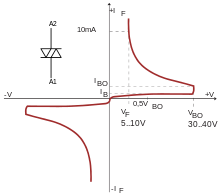
Back الدياك Arabic ডায়াক Bengali/Bangla Diac Catalan Diak Czech Diac Danish Diac German Diac Spanish Diiak ET DIAC EU دیاک FA
This article includes a list of references, related reading, or external links, but its sources remain unclear because it lacks inline citations. (February 2020) |
| Type | Passive |
|---|---|
| Pin names | anode 1, anode 2 |
| Electronic symbol | |
 | |

The DIAC (diode for alternating current) is a diode that conducts electrical current only after its breakover voltage, VBO, has been reached momentarily. Three, four, and five layer structures may be used.[1] Behavior is similar to the voltage breakdown of a triac without a gate terminal.
When breakdown occurs, internal positive feedback (impact ionization or two transistor feedback) ensures that the diode enters a region of negative dynamic resistance, leading to a sharp increase in current through the diode and a decrease in the voltage drop across it (typically full switch-on takes a few hundred nanoseconds to microseconds). The diode remains in conduction until the current through it drops below a value characteristic for the device, called the holding current, IH. Below this threshold, the diode switches back to its high-resistance, non-conducting state. This behavior is bi-directional, meaning typically the same for both directions of current.
Most DIACs have a three-layer structure with breakover voltage of approximately 30 V and an on voltage of less than 3 V. Their behavior is analogous to the striking and extinction voltages of a neon lamp, but it can be more repeatable and takes place at lower voltages.
DIACs have no gate or trigger electrode, unlike some other thyristors that they are commonly used to trigger, such as TRIACs. Some TRIACs, like Quadrac, contain a built-in DIAC in series with the TRIAC's gate terminal for this purpose.
DIACs are also called "symmetrical trigger diodes" due to the symmetry of their characteristic curve. Because DIACs are bidirectional devices, their terminals are not labeled as anode and cathode but as A1 and A2 or main terminal MT1 and MT2.
